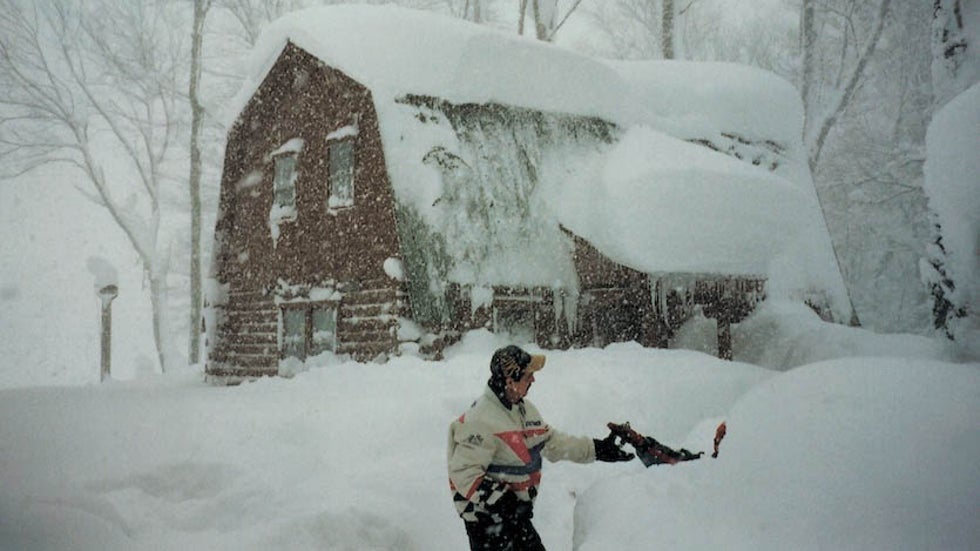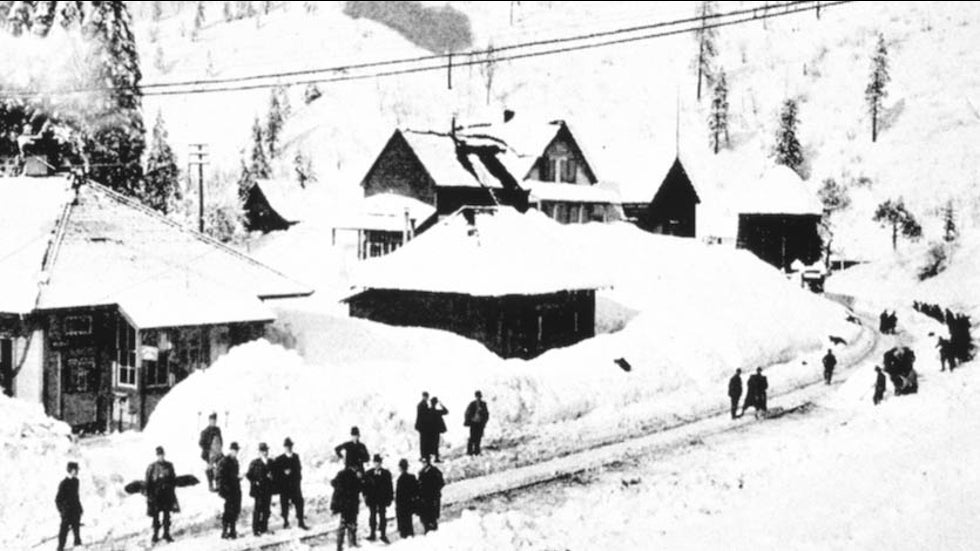Snow can pile up several feet in a day's time when conditions are ripe in many U.S. states.
In fact, 48 of 50 states have received more than a foot of snow during a single 24-hour period, according to data from NOAA's National Centers for Environmental Information (NCEI). Of those 50 states, 32 of them – mostly in the West, Midwest and Northeast – have had snowfalls of 30 inches or more in 24 hours.
During those extreme situations, snowfall rates are often an inch or more per hour. Thundersnow also sometimes occurs, an indication of unstable air and strong upward motion in the atmosphere, resulting in heavy snow.

States With the Biggest 24-Hour Snowfall Records

Colorado leads the pack with the most extreme 24-hour snowfall record in the Lower 48 states.
If you were 6 feet tall and standing outside for 24 hours in Silver Lake, Colorado, April 14-15, 1921, you would've been buried by snow from head to toe. That location saw 6.3 feet (75.8 inches) of snow high in the Rockies at an elevation of 10,220 feet above sea level.
One location in Alaska, however, takes the crown for all 50 states.
Tucked away in the mountains northeast of Valdez, Alaska, is Mile 47 Camp, which was buried by 78 inches of snow in the 24 hours ending Feb. 9, 1963. Here, winter storms in the Gulf of Alaska send moisture from the Pacific into the mountainous terrain, making it an ideal spot for incredible snowfall totals.
Three other states have had 24-hour snowfalls that exceeded 50 inches, and much like the top two locations, mountainous terrain played a role in squeezing out those extreme totals.
Those states are California (67 inches in the Sierra Nevada), Washington (65 inches in the Cascades) and South Dakota (52 inches in the Black Hills).
Recent 24-Hour Snowfall Records Broken
Five U.S. states have set new 24-hour snowfall records during the past 13 years.

Connecticut is the most recent state to rewrite the record books when a location near Ansonia saw 36 inches Feb. 8-9, 2013. That new benchmark for the state was set during Winter Storm Nemo, which also hammered several other New England states with more than a foot of snow.
About two years earlier, Oklahoma set a new 24-hour snowfall record when 27 inches piled up in Spavinaw Feb. 9-10, 2011.
A single spring blizzard in March 2009 propelled two states to new 24-hour records. Pratt, Kansas, and Follett, Texas, made state history with 30 inches and 25 inches of snow, respectively, in the 24 hours ending March 28, 2009.
The fifth state to set a new record in the last 13 years is Nebraska, where 27 inches was measured near Dalton in the 24 hours ending Dec. 21, 2006.
More on 24-Hour Snowfall State Records
Here are some other notables on 24-hour snowfall records in the U.S.:
- Oldest records: The two records that have stood the longest are 36 inches in Astoria, Illinois, during the 24 hours ending Feb. 28, 1900, and 49 inches at Watertown, New York, Nov. 14-15, 1900.
- Two states with less than a foot in 24 hours: Florida and Hawaii are the only two states with record 24-hour snowfall totals of less than one foot. No official records exist, but Mauna Kea and Mauna Loa on Hawaii's Big Island may have seen a foot or more of snow in 24 hours. Florida's record 24-hour snow was 4 inches near Milton, which oddly occurred in early March 1954.
- Unofficial higher totals in some states: A few states have unofficial higher snowfall totals not recognized by NOAA. This includes a 55.5-inch total at Alta Guard Station in Utah Jan. 5-6, 1991, and a 54-inch total in New York's Tug Hill Plateau in January 1976. Finally, Louisiana's 24-hour total may be higher than the 13 inches NOAA has for the state. Winter storms in February 1898 and December 1929 may have topped it, but data from those storms is not reliable.
Other Candidates for State (and National) Snow Records
Christopher Burt, weather historian at Weather Underground, has also done research on this topic and found data for some states that could trump NOAA's reported totals, although they are not recognized as official records.
A report of 77 inches in 24 hours in Montague, New York, on Jan. 11-12, 1997, was investigated by an ad hoc committee organized by the National Weather Service. That observation was determined to be invalid because too many measurements were made within the 24-hour period in question.
Official NWS records require snowfall to be measured four times in a 24-hour period – every 6 hours – but the observer took six measurements, which resulted in a higher total than would have otherwise been reported.

Despite the incorrect measuring techniques in Montague, the NWS report noted that the snow depth on the ground increased by 51 inches in 24 hours, implying that more snow fell in 24 hours than the official state record for New York – 49 inches in Watertown on Nov. 14-15, 1900. NOAA also lists an unofficial but credible record for New York of 54 inches in Barnes Corner on Jan. 9, 1976, during the same storm that also dumped 68 inches in 24 hours in nearby Adams.
Surpassing any of the possible contenders for the U.S. 24-hour snowfall record – including Mile 47 Camp in Alaska – is the 84 inches measured in one 24-hour period at the Crestview maintenance station of the California Highway Department on Jan. 14-15, 1952.
The storm total was 149 inches over the week of Jan. 11-17, 1952, a number that became famous because of the Southern Pacific Railroad’s flagship train, City of San Francisco, becoming trapped in the snow near Donner Pass for three days beginning Jan. 13. The train lost power and food supplies for the 226 passengers before a rescue party arrived.
Another possible candidate for a U.S. snow record comes from near the same location in the Sierra Nevada: a single-storm record of 194 inches measured at the Norden train depot near Donner Summit, April 20-23, 1880. The measurement is consistent with surrounding observations, including Sacramento’s still-standing 24-hour rainfall record of 7.24 inches set April 20-21, 1880 (and 8.81 inches total over a 48-hour period). Read more about this historic storm in a Weather Underground blog entry that Burt posted in April 2015.

Here are a few other candidates for state snowfall records, according to Burt's research:
Maine: 41.8 inches were measured in 24 hours at Eustis, Dec. 21-22, 2008, according to a CoCoRaHS observer.
Montana: The United States Weather Bureau monthly climatological summary for January 1916 reported a snow depth of 216 inches at Libby site 2 (6,000 feet above sea level) at the end of the month (Jan. 31, 1916).
Vermont: Jay Peak Ski Resort claimed a 571-inch seasonal snowfall total in 2000-01, and 417 inches in 2007-08.
Wisconsin: Spooner measured a 45-inch storm total on March 10-15, 1899. Note that this snowfall was not directly measured; Instead, it was inferred from the moisture in snowmelt, using a 10-to-1 ratio, in which 10 inches of snow is produced by 1 inch of liquid water. If the snow ratio in Spooner was greater than 10-to-1, which is often the case, the storm total was likely even higher.
The Weather Company’s primary journalistic mission is to report on breaking weather news, the environment and the importance of science to our lives. This story does not necessarily represent the position of our parent company, IBM.
The Weather Company’s primary journalistic mission is to report on breaking weather news, the environment and the importance of science to our lives. This story does not necessarily represent the position of our parent company, IBM.

No comments:
Post a Comment